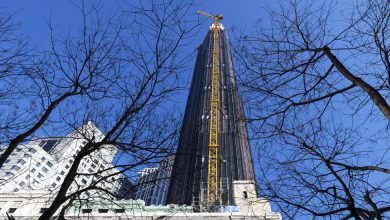Unraveling a High-Rise Horror Story

Times Insider explains who we are and what we do, and delivers behind-the-scenes insights into how our journalism comes together.
Last month, when Karen Zraick, a Times reporter on the Metro desk, got a tip from a tenant of a Lower Manhattan residential building, she wasn’t sure it would result in an article. The tipster wrote that elevator service in the building had been spotty, at best, since the fall. But elevator outages are unfortunately fairly common in New York City, particularly in the city’s public housing complexes, Ms. Zraick thought.
But one thing about this outage was unusual: This person’s building had 59 floors, 56 of them residential. Though the elevator bank servicing floors one through 15 worked fine, the elevators that carried passengers to the 16th floor and higher were known to break down. Residents of the highest floors could face a long, grueling climb to return home, meaning that filling a prescription or mailing a package could become hourslong odysseys.
The sheer height of the building made the problem something totally out of the ordinary. “I was like, ‘Wow, that’s crazy,’” Ms. Zraick said.
Over the next three weeks, she and Ashley Wong, a reporting fellow on the Metro desk, spoke with more than a dozen residents at the building, 20 Exchange Place, a bustling high-rise in the Financial District with both luxury amenities and some rent-controlled units. Residents described experiences that were taxing (try walking up 33 flights of stairs after a 12-hour shift as a nurse) and, for some, debilitating — those with mobility issues couldn’t navigate stairs at all. Residents couldn’t move out without a reliable elevator.
Some residents, unable or unwilling to make the climb, even packed a change of clothes before a night out in case they needed to stay in a hotel, not knowing if the elevator would be working upon their return.
Though residents of the building were fuming, the biggest initial challenge in reporting, Ms. Zraick said, was getting people to go on the record. Some had signed nondisclosure agreements with the building; others feared reprisals from management if their names appeared in the newspaper.
So she got creative. A tenant posted Ms. Zraick’s number inside one of the (working) elevators, and others began circulating it to friends, neighbors and, crucially, members of the building’s group chat. Soon, Ms. Zraick was overwhelmed with dozens of calls, emails, texts and social media messages. That’s when she enlisted the help of Ms. Wong, who followed up by phone with those who wanted to share their stories.
When the word got around, Ms. Wong said, “everyone wanted to talk to us.”
The obvious inconvenience was the physical one, Ms. Wong said, but as she talked to more people, she realized she and Ms. Zraick also would need to account for the anxiety of not having reliable elevator service for nearly five months — or worse, the prospect of getting stuck inside an elevator.
“Even those who were physically capable of walking up and down felt trapped because of the uncertainty,” she said. “The elevators aren’t completely shot, but you never knew when they would arrive. People were in a constant state of uncertainty, helplessness and despair.”
After talking to residents — and, in Ms. Zraick’s case, visiting the building (where the elevators, predictably, weren’t working) — the reporters reached out to the building’s owners, DTH Capital. The company was apologetic, Ms. Zraick said, but was also unwilling to accept blame, placing the onus on the electric company, Con Edison. The utility company said it had been unable to find the cause of the outages but said testing had indicated that it was not a power supply issue. “No one disputes that this is a problem,” Ms. Zraick said. “But they both don’t know how to fix it and think the other party is at fault.”
Since the article was published online on March 28, calls, texts and emails have continued to pour in from residents.
The article sparked conversation on social media. It has also received some criticism from readers, who note that elevators in public housing, which are often poorly maintained, break all the time. Why are breakdowns in a luxury residential building, where one-bedroom units can go for as much as $5,000 per month, news? That was a perspective, Ms. Zraick said, that her editor, Johanna Barr, encouraged the reporters to consider early in the process — and to address in the article. In this case, the fact that the building was a skyscraper was uncommon and the situation felt worth exploring.
As of press time, Ms. Zraick said, the outages were still ongoing — and residents were still calling.
“We’re definitely planning to continue to follow this story,” Ms. Zraick said. “And hopefully, for their sake, it’s fixed sooner rather than later.”
Source link






